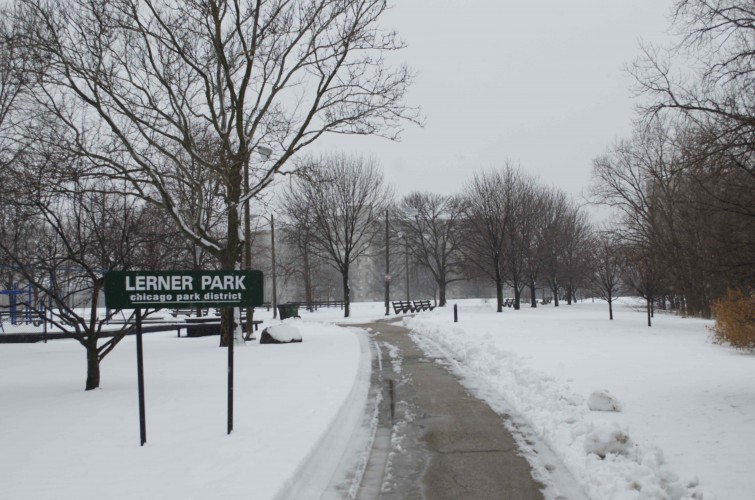
After Susan Pinto, 38, heard reports that neighbors and relatives had spotted coyotes close to her home, she started blocking off her doggy door while she and her husband were at work.
Animal lovers think of their pets as a part of the family, and North Side native Pinto is no exception. For Pinto, providing her Rat Terrier-Cocker Spaniel mix, Bacchus, with a flexible bathroom schedule and more time outdoors was important enough that she relocated from downtown Chicago to a house in Rogers Park. The comfort that she could provide Bacchus with freedom in the form of a doggy door was displaced by fear when a series of coyote sightings were reported blocks from where Bacchus conducts his business.
Pinto lives about half of a mile away from the North Branch of the Chicago River that runs along Kedzie avenue on the east and McCormick boulevard on the west. The secluded, wooded area that surrounds the river is an ideal location for coyotes to hideout. Robin Koloms, resident, stated in an email that she has seen coyotes along McCormick and Kedzie between Pratt Boulevard and Touhy Avenue as well as running through Lerner Park- located on Sacramento and Lunt avenues.
“I was initially under the impression that [coyotes] were 50 lbs. and looked like an emaciated German Shepherd,” Pinto said in a telephone interview. With 6-year-old Bacchus being around 30 lbs. that large of a predator invading her yard would create a risk to Bacchus that Pinto was not willing to take.
Dedicated pet owners represent just one group struggling to handle the invasion of the wild, predatory animal on our city streets. Though coyotes are known for their stealth, the once named “ghosts of the plains” are becoming increasingly comfortable in urban settings and in turn less fearful of human residents. The frequency in which they are seen leads to increasing unease for human counterparts of the domesticated animals that are at at the highest risk.
Kelli Miller, 35, lives near another Rogers Park coyote hot spot-Robert Black golf course in Warren Park. Miller’s dog Ralph is large enough that she is not worried about him being able to defend himself, but she walks a Chihuahua-sized pup that she says is a “perfect meal size for a coyote,” and at a greater chance of attack.
“My concern is that I won’t see a coyote coming and it’ll snatch away the little guy, or bite him,” Miller stated in an email.
While coyotes are not the strangest or most dangerous animal to wander Chicago streets, the breed has been the subject of many headlines throughout the area in recent years.
In January an attack was reported in the Chicago suburb of Riverside when a group of four coyotes chased a 5-year-old beagle named Snoopy from his yard and broke glass and wooden panels of a door in an attempt to reach the dog inside.
It is the rare, newsworthy coyote interactions like Snoopy’s that cause pet owners to believe coyotes are more dangerous than they are. In reality, this type of attack is an anomaly. Not only do coyotes typically hunt alone, but coyotes attacking pets are exceedingly rare said Brad Powers, assistant to the director of Chicago Animal Care and Control.
According to the Cook County Illinois Coyote Project, there were 70 attacks on domesticated dogs and 10 on cats from 1990 through 2004. The data suggests that cats may occasionally be taken as food, but dogs are more commonly attacked for territorial reasons during breeding season which runs from January to April.
That information offers some comfort to pet owners, but many are still wary.
“I think at first, when people began mentioning that they were seeing more coyotes in the area, I was a little nervous and uneasy about it,” Miller said. “I’m still not entirely comfortable with the idea of something like a pack of coyotes living in the park a couple blocks from my home. I do avoid the park at night and during the early morning hours, when the coyotes are more active. My concern is still valid and still exists, but maybe just a little more subdued.”
After doing research, talking to fellow dog owners, and some persuasion from her husband, Pinto eventually unblocked the doggy door.
“I still have a sense of uneasiness,” Pinto said. “When I get home [and see him] I am relieved.”
Related articles
 Coyote Attacks Prompt Warnings For Dog Owners In Broomfield(denver.cbslocal.com)
Coyote Attacks Prompt Warnings For Dog Owners In Broomfield(denver.cbslocal.com)
 Coyotes smash door of Chicago suburb home(usnews.nbcnews.com)
Coyotes smash door of Chicago suburb home(usnews.nbcnews.com)













Be First to Comment